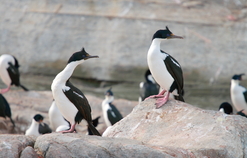
Blue-eyed shags feed mainly on fish and invertebrates, often forming dense "rafts" at sea of hundreds of birds that continuously dive down onto the shoals below looking for fish. By fishing in such large groups they help each other by panicking the fish into having nowhere to go except into the beak of the next bird. They are excellent divers with a recorded maximum dive of 400 feet. Once underwater they are able use their powerful webbed feet to propel themselves rapidly in search of food.
The nests of these gregarious birds are built on cliff tops close to the ocean. The colonies can become quite raucous and lively affairs, especially during the breeding season. Courtship activities begin in late August to early October. Up to three eggs are laid in October through to early January and these hatch in November to February. Unlike other Antarctic birds, Shag chicks are born "naked", meaning without any down feathers. This makes them susceptible to extreme weather and especially dependent on their parents when very young. Fledging occurs in January to March, and the adults leave the colonies in April.
The main predators of Blue-eyed shags are the sheathbill, which steals eggs from the nest, and leopard seals, which attack the birds at sea.
Cormorants do not seem to be under any current threat, however, but some populations are so small (a few hundred pairs) that their status needs monitoring.



